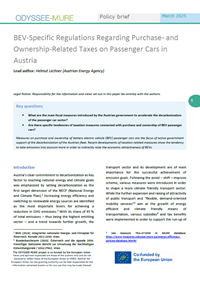Summary
Key questions
- What are the main fiscal measures introduced by the Austrian government to accelerate the decarbonisation of the passenger car sector?
- Are there specific tendencies of taxation measures connected with purchase and ownership of BEV passenger cars?
Lead authors: Helmut Lechner (Austrian Energy Agency)
Measures on purchase and ownership of battery electric vehicle (BEV) passenger cars are the focus of active government support of the decarbonisation of the Austrian fleet. Recent developments of taxation related measures show the tendency to take emissions into account more in order to indirectly raise the economic attractiveness of BEVs.
Introduction
Austria’s clear commitment to decarbonization as key factor to reaching national energy and climate goals was emphasized by setting decarbonization as the first target dimension of the NECP (National Energy and Climate Plan). Increasing energy efficiency and switching to renewable energy sources are identified as the most important levers for achieving a reduction in GHG emissions.1 With its share of 45 % of total emissions – thus being the highest emitting sector – and a trend towards further growth, the transport sector and its development are of main importance for the successful achievement of emission goals. Following the avoid – shift – improve scheme, various measures were introduced in order to shape a more climate friendly transport sector: While the further expansion and raising of attractivity of public transport and “flexible, demand-oriented mobility services”2 aim at the growth of energy efficient and climate friendly means of transportation, various subsidies3 and tax benefits were implemented in order to support the run-up of zero-emission vehicles (ZEV) in road transport (with battery-electric vehicles (BEV) being the subcategory of by far most importance). While the rising numbers of registrations of BEV passenger cars lead to a BEV share in Austria well above EU average and next to the Scandinavian and Benelux countries4 , a remarkable bend in the development of BEV sales has occurred since the phase-out of subsidies for commercial purchases of BEV at the beginning of 2024. As the share of commercial registrations is currently accounting for about two thirds of total new registrations and about 80 % when considering BEV registrations only5, the commercial passenger cars market is of key importance for the development of the national fleet and its powertrain composition. Thus, an ongoing of the current trend of decreasing new registrations of non-emission passenger cars would severely impact the decarbonization of the transport sector.
At the same time, Austria is facing budgetary deficit and the threat of recession with possible consequences such as declining consumption and government revenue as well as measures resulting from austerity policy. In this situation, while taxes, duties and other governmental revenues resulting from street traffic already account for about 6 % of Austrias governmental revenues6, these fiscal measures and their adaption could come into focus even more as tools to both shape the future national fleet as well as to generate additional government revenue.
After a brief overview of the fiscal measures with direct or indirect impact on the attractiveness of ZEV in relation to internal combustion engine (ICE) based passenger transport, current fiscal measures aimed at the purchase and ownership of passenger cars and their implications for zero-emission cars will be presented.
BEV Specific Fiscal Policy
Various subsidies as well as taxes and duties implemented by the Austrian state aim at directing demand from ICE vehicles to ZEV/BEV. While some existing measures were adapted to steer demand towards more climate friendly means of transportation, others were created to meet this goal. As Austria is a federal republic, also measures implemented by the federal states such as complementary or additional subsidy grants on the purchase of BEV and charging infrastructure need to be mentioned but cannot be presented in detail due to the scope of this article.
The common goal of both subsidies as well as taxation regulations is to raise relative attractiveness of climate friendly, zero-emission powertrains, particularly BEVs. While the gradual (introduction and) increase of taxes on the ownership and use of ICE vehicles and the fuels connected with them aims at internalizing negative external effects of ICE, intended to lead to a decline in demand of fossil fuels and ultimately the decline in demand of ICE-powered vehicles, subsidization and taxation incentives for BEVs are intended to shift that demand towards more climate friendly means of street transport by lowering the effective cost of these for companies and consumers. Besides For a systematic depiction the fiscal measures implemented in Austria can be structured by using the following distinctions:
- Does the measure refer to a payment to the state (tax) or a payment from the state (subsidy)?
- Is the measure’s recipient a private person or a legal person (an organisation)?
- What is the object of the measure?
- Is it a one-off measure or measure on a regular basis (determined by time or usage)?
Not included in this depiction are the following costs and benefits:
- Registration fee: A minor administrative fee due at the registration of any passenger car and therefore powertrain neutral.
- Exemptions from standardised consumption tax (“Normverbrauchsabgabe” NoVA) are not related to the powertrain of the vehicle.
- Road tolls are powertrain neutral, as there are no exemptions for BEV in Austria.
- Costs connected with parking management, as these measures are regulated by the federal states and municipalities.7
- Finally, the implications of the climate-bonus („Klimabonus“)8 for the passenger transport sector will be discussed in the concluding section.
Introducing a further dimension, the point in time of the effect of the measure within the life cycle of the vehicle (purchase, ownership and operation, disposal) is used in the overview of the central fiscal policies (see Table 1) according to the introduced scheme.
Resulting from the overriding goal of increasing the relative attractiveness of zero-emission transport, subsidies and tax incentives (lower tax rates or exemption from taxes) will typically concern BEV, while the raise of tax rates will apply to ICE. However, the frequency of the measure (one-off versus regular basis) shows a more complex picture: While measures favouring BEV have a tendency to support demand of vehicles directly in order to achieve a more climate friendly composition of the future national fleet and therefore are based on acquisition and ownership, measures aiming at reducing demand of ICE vehicles (and thus at the existing fleet) tend to operate on the base of consumption i.e. emission-based taxation – most notably the mineral oil tax, accounting for by far the most revenue of all road traffic related taxes.
While some of the regulations also favour hybrid electric vehicles (HEV) as their lower level of emissions accounts for the basis of calculations or only their ICE-share is being considered for calculations, some advantages are eligible for BEV exclusively, such as the VAT exemption, e-mobility grants and options for depreciation.
Purchase- and Ownership-Related Tax Regulations on BEV Passenger Cars
In the following section taxation measures based on the purchase and ownership of passenger cars will be introduced in more detail. These are by definition not dependant on the extent of use – with the notable exception of the tax-free private use of company cars: in this case a use-dependent component was introduced and strengthened by recent reform and amendment of the regulations.
Input VAT Exemption for BEV Company Cars
Since 2016, input VAT exemption for zero-emission company cars increases the relative economic attractiveness of BEV/zero-emission cars by effectively lowering their purchase cost for companies.
Table 1: Overview of Zero-Emission Vehicles Specific Fiscal Policy Measures
| Measure | Type | Target Audience | Object | Frequency | Position in Life Cycle |
| Input VAT exemption for zero-emission company cars | tax | organisation | vehicle | one-off | purchase |
| Grant for BEV passenger cars | subsidy | private | vehicle | one-off | purchase |
| Grant for charging infrastructure | subsidy | private or organisation | infrastructure | one-off | purchase |
| Grant for utility vehicles | subsidy | organisation | vehicle | one-off | purchase |
| Grant for passenger cars for social institutions, e-taxis, e-carsharing, and driving shools (limited target group) | subsidy | organisation | vehicle | one-off | purchase |
| Standardised consumption tax | tax | private or organisation | vehicle | one-off | registration |
| Engine related insurance tax / motor vehicle tax | tax | private or organisation | vehicle | regular | ownership |
| Mineral oil tax | tax | private or organisation | fuel | consumption-driven | operation |
| Exemption of private use from income tax | tax | private or organisation | vehicle | regular | operation |
| Exemption of private use from income tax for charging current | tax | private or organisation | energy | regular | operation |
| Options depreciation BEV | tax | private or organisation | vehicle | regular | ownership |
Source: Author
This is done by enabling companies to claim input VAT: In Austria, passenger cars are not owned by companies under financial law. Therefore, the company cannot claim input VAT on their purchase, maintenance, and use (fuel). Thus, the company also must pay input VAT. This also refers to motorised two-wheelers, but not to light goods vehicles or other vehicles. However, zero-emission passenger cars - this refers to battery-electric and fuel-cell electric cars - are exempted. Thus, no input VAT has to be paid. There is a threshold of 40,000 EUR called the "appropriateness limit". Up to this level, the entire purchase price is subject to an input tax deduction. For higher purchase prices up to 80,000 EUR, "own consumption taxation" is to be applied for higher purchase prices, no VAT can be deducted for the entire purchase price. Further input taxes can be deducted for maintenance of the vehicle (Around 1/6 of costs). Since 01.01.2020 motorcycles and e-bicycles with a CO2-emission of 0 grams have also been exempt from the input VAT.9
Exemption from Standardised Consumption Tax for BEV
The exemption of zero-emission vehicles from standardised consumption tax increases the relative economic attractiveness of BEV/zero-emission cars by effectively lowering their purchase cost.
Standardised consumption tax (NoVA) must be paid when a passenger car or a motorcycle is registered in Austria for the first time. The tax is based on the purchase price and the CO2-emissions of the vehicle. Full electric and hydrogen cars with 0 CO2-emissions are excluded from the tax. The standardized fuel consumption tax was introduced in 1992. It is calculated as a percentage rate of the purchase price. As the tax is progressively linked to CO2 emissions of the vehicle, NoVA is an incentive to buy more efficient vehicles regardless of the expected mileage.10
NoVA must be paid for passenger cars, small buses, vans, recreational vehicles, motorcycles, and some special vehicle such as quad bikes. Vehicles for special purposes such as driving schools, taxis, rental cars and ambulance and fire brigades, but also all vehicles registered for freight transport are exempt from NoVA taxation. This also refers to full electric vehicles (BEVs). The amount of the standard NoVA is calculated based on CO2 emissions of the vehicle measured by the WLTP (Worldwide harmonized Light vehicles Test Procedure) for passenger cars.10 While the NoVA was adapted several times, most often to support the market introduction of alternative fuel vehicles. A substantial adjustment of the NoVA was realised in February 2021 getting into force in July 2021:10
- WLTP (Worldwide harmonized Light vehicles Test Procedure) instead of NEDC (New European Driving Cycle) as basis for calculations,
- penalties for highly polluting vehicles,
- annual tightening of tax rates and exemptions until 2024 were fixed.
The standard consumption tax NoVA – comparable with measures in Norway, Denmark, France, Hungary, Ireland, or Spain11 – influenced the vehicle market shortly before and after its first introduction. Shortly before, the share of sales of cars with higher consumption increased, as buyers of small cars waited for the introduction. Shortly after the introduction of the tax, the share of cars with lower fuel consumption correspondingly increased. However, in the following months the trend toward motor vehicles with lower fuel consumption has not materialised, mainly because of the fall in fuel prices taking place in the respective period.10
Exemption from Engine-Related Insurance Tax for BEV
The exemption of zero-emission vehicles from the engine-related insurance tax (“motorbezogene Versicherungssteuer” for vehicles with a maximum permissible weight below 3.5 tons) increases the relative economic attractiveness of zero-emission cars by lowering their cost of ownership.
For vehicles with a maximum permissible weight above 3.5 tons, the tax depends on the maximum weight of the vehicle. For smaller vehicles, the tax depends on the engine power and for vehicles firstly registered after 10/2020 also from their CO2-emission level. In both cases, battery-electric and hydrogen vehicles are exempt from the tax. The latest amendment of the taxation of vehicles was enacted to assist in forming a more environmentally friendly vehicle fleet. The tax for hybrid electric vehicles depends solely on the power of the combustion engine.12
After the introduction of the “KFZ-Steuer” (motor vehicle tax) in 1978, which was calculated based on engine size and in 1985 expanded with the catalyst requirement, the measure was renamed in 1993 and is since then calculated based on engine power. “A reform of the tax from an ecological point of view was implemented for all newly registered vehicles from November 2020 onwards. Zero-emission vehicles remain tax-free. The new tax regime combines two components – one based on the engine power, the second one based on the CO2-emissions – comparable to Denmark’s Green Owner Fee13 or the temporary exemptions in Germany and Italy and exemptions in Hungary, Latvia, or the Netherlands.14 For the second component, different thresholds are applied for a measurement whether it is measured using WLTP or NEDC.”15 While the yearly decrease of thresholds favours the purchase of smaller and more environmentally friendly cars, the complete exemption of zero-emission cars marks an even stronger impulse to purchase emission-free vehicles – comparable to measures in Germany (TRA-DE2159, TRA-DE4045) or Denmark (TRA-DK2065).
Tax-Free Private Use of BEV Company Cars and Charging Power
This measure increases the relative attractiveness of the use of zero-emission cars by lowering the effective cost of their private use for employees while offering additional means of tax-deferred renumeration for employers. With the amendment of 2024 concerning charging infrastructure and charging power, an extension of the advantages of the private use of company cars as well as a use-dependant component has been added.
Employees are allowed to use company cars for private purposes. This non-monetary remuneration increases the assessment basis for income tax (of the employee) and social security contributions (of employee and employer). However, the tax is waived if a zero-emission car is selected. This is also valid for company bikes. Employees are allowed to use company cars for private purposes as a non-monetary remuneration for which taxes are to be paid. This non-monetary remuneration increases the assessment basis for income tax (of the employee) and social security contributions (of employee and employer). For this purpose, employees have to pay 2 % of the vehicle purchase price monthly (maximum of 960 EUR) as a tax. If the vehicle has low emission values, the non-monetary remuneration decreases to 1.5 % and a maximum of 720 EUR. The respective CO2-emission threshold accounts for 141 g/km for vehicles registered for the first time after 31. March 2020 and is reduced by 3 grams per year from 2021 to 2025. However, the non-monetary remuneration is decreased to zero for vehicles without local CO2 emissions and thus for battery-electric and fuel-cell electric vehicles. This regulation also decreases the social security contributions of the employer. Since 2019 also e-bikes are covered. Employers might provide the employee with an e-bike for exclusive use by this employee – also in leisure time. This, again is regarded a tax-free remuneration.16
In 2024 the advantages of private use of company owned, zero-emission cars were extended to include the charging of said cars – comparable to regulations in Germany,17 Denmark or Finland.18
- Free charging at work is not added to the assessment basis of the income-tax,
- Employer provided charging at public charging stations (by providing a charging card or by reimbursing costs), are exempt from taxes and duties for the employee,
- The costs for charging at home can be reimbursed free of tax and duty by the employer for electricity that can be clearly allocated to the electric company vehicle. For calculation, an average electricity price has been set by the Federal Ministry of Finance ad well as an amount of up to 30 Euro per month if a clear allocation of the charging costs is not possible.19
As a further component, also the purchase and installation of charging infrastructure at the employees home paid in whole or in part by the employer, is exempt from the assessment basis of the income tax up to 2,000 EUR.
Options for Depreciation of BEV
A further taxation advantage of electric company cars compared to ICE company cars was created in 2020: An option was introduced to depreciate certain assets (including electric vehicles) using the declining balance method. A percentage of up to 30 % might be applied to the respective (residual) carrying amount, resulting in significantly faster depreciation (comparable to measures in Ireland and Sweden20), particularly in the first few years.
Conclusion
Taxes on vehicles not only serve fiscal purposes, but also traffic and environmental objectives. In recent years, some amendments of the taxation of vehicles were enacted to contribute to a more environmentally friendly vehicle fleet. While acquisition and ownership of zero-emission – in most cases battery-electric – vehicles were made more attractive to support the decarbonisation of passenger road transport by reducing the effective price gap between ICE and BEV alternatives, the regulations concerning variable (mainly energy) costs only affect the lowering of relative attractiveness of fossil fuels by emission-based enhancement of tax rates. However, at the same time, revenues of CO2-taxation are used to finance the so-called climate-bonus.21 A payment to all Austrian citizens, staggered by regions depending on their respective mobility prerequisites. Households with a higher probability of additional financial burden induced by rising costs of high emitting means of transportation, thus are supported more than others. While being intended as a social measure to reduce the impacts of rising inflation, this measure holds the tendency of subsidising emission intensive mobility, as households in regions depending more on emission intensive means of transportation are supported more without connected incentives to invest the support into more climate friendly means of transportation.
While the continuation of incentives to shift demand towards zero-emission passenger cars for both the commercial as well as the private market seems necessary to ensure the development of a lower emitting national fleet, and though CO2-dependant elements of taxation were introduced to lower demand for high emission means of transportation, and registration and ownership taxes are differentiated regarding specific emissions, in the medium and long term the pricing of transport must take emissions into account even more to consequently meet the goal of decarbonising road transport.
Notes
- 1: BMK (2024): Integrierter nationaler Energie- und Klimaplan für Österreich. Periode 2021-2030. Wien
- 2: Bundeskanzleramt (2020): Österreich und die Agenda 2030. Freiwilliger Nationaler Bericht zur Umsetzung der Nachhaltigen Entwicklungsziele / SDGs (FNU). Wien
- 3: See measure TRA-AT1956 in MURE database: https://www.measures.odyssee-mure.eu/energy-efficiency-policies-database.html#/
- 4: The European Automobile Manufacturers’ Association (ACEA) (2025): Vehicles on European Roads. [https://www.acea.auto/files/ACEA_Report_-_Vehicles_on_European_roads_2025.pdf], 6 March 2025
- 5: Statistik Austria (2024): Pressemitteilung: 13 468-234/24. Pkw-Neuzulassungen im Zeitraum Jänner bis Oktorber 2024 um 5,6 % gestiegen. Wien
- 6: VCÖ (2025): Lenkungswirkung von Steuern im Verkehr erhöhen, Steuersystem an Dekarbonisierung anpassen. [https://vcoe.at/themen/lenkungswirkung-von-steuern-im-verkehr-erhoehen-steuersystem-an-dekarbonisierung-anpassen], 6 March 2025
- 7: See measure TRA-AT1959 in MURE database.
- 8: See measure GEN-AT5403 in MURE database.
- 9: See measure TRA-AT4140 in MURE database.
- 10: See measure TRA-AT1951 in MURE database.
- 11: see measures TRA-NO2330, TRA-DK2066, TRA-FR2122, TRA-HU2197, TRA-IE2205 and TRA-ES2446 in MURE database.
- 12: See measure TRA-AT1949 in MURE database.
- 13: see measure TRA-DK2065 in MURE database.
- 14: ACEA (2024): Tax Benefits and Incentives. Electric cars | 27 EU member states (2024). [https://www.acea.auto/files/Electric-cars-Tax-benefits-purchase-incentives_2024.pdf.pdf], 6 March 2025
- 15: See measure TRA-AT1949 in MURE database.
- 16: See measure TRA-AT4141 in MURE database.
- 17: See measure TRA-DE2168 in MURE database.
- 18: ACEA (2024): Tax Benefits and Incentives. Electric cars | 27 EU member states (2024). [https://www.acea.auto/files/Electric-cars-Tax-benefits-purchase-incentives_2024.pdf.pdf], 6 March 2025
- 19: ÖAMTC (2025): Firmenfahrzeug zur Privatnutzung. [https://www.oeamtc.at/thema/steuern-abgaben/firmenfahrzeug-zur-privatnutzung-18178952], 28.01.2025
- 20: See measures TRA-IE5175, TRA-SE2463 in MURE database.
- 21: See measure GEN-AT5403 in MURE database.






